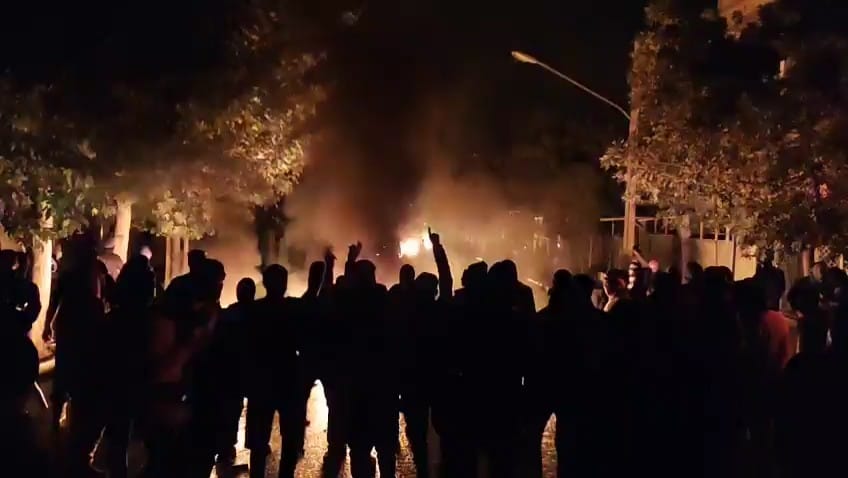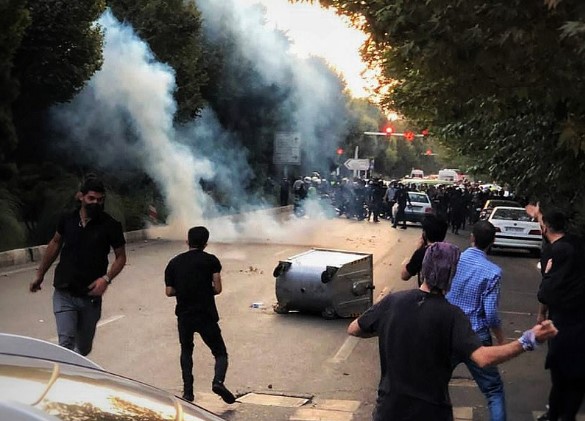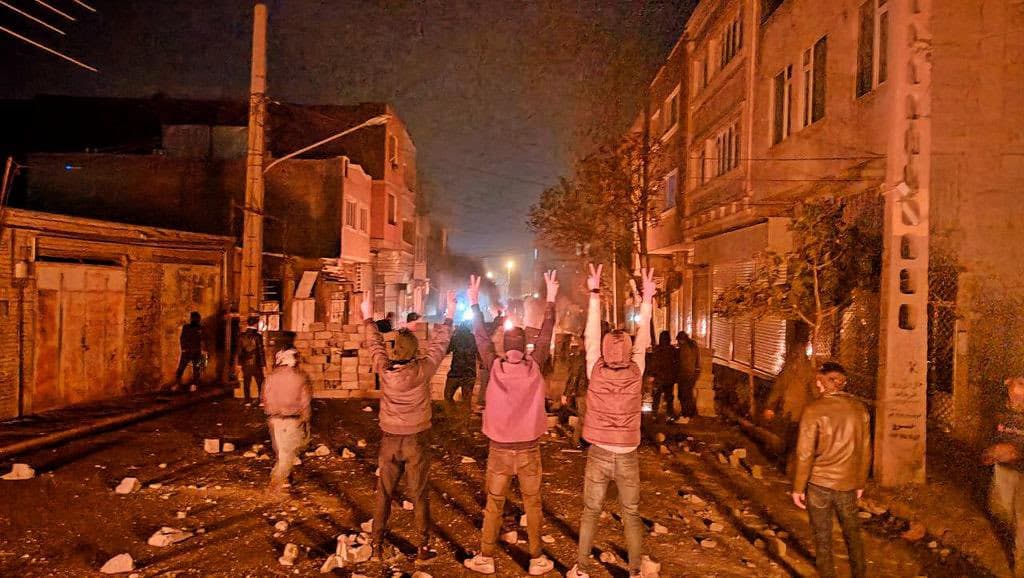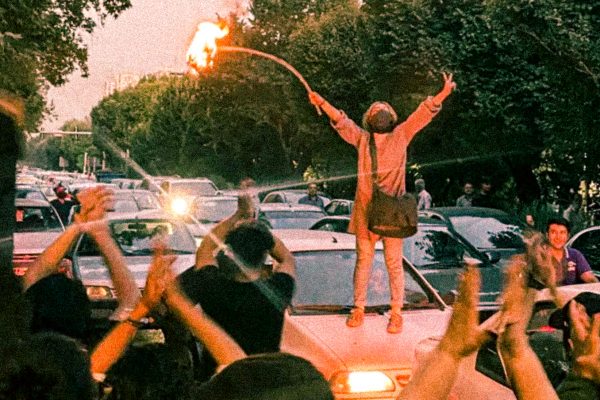Saturday 16 September marked the first anniversary of the murder of Mahsa Jina Amini, which sparked the ‘Women, Life, Freedom’ uprising in Iran last year. It was commemorated with a bazaar strike in Kurdish towns, and with street protests by the youth in Tehran, Kermanshah, Sanandaj, Amol, Hamedan, Rasht and Bukun, among other cities.
The regime was well prepared, with a heavy security force presence, which responded brutally. On that weekend alone there were 163 arrests. This was expected. In the months since the end of the uprising, the regime has unleashed a wave of brutal repression, with more than a dozen executions, alongside continuous arrests, and the blacklisting of students and workers.
Last year's youth uprising lasted for four months and spread to every city and town in Iran. It was the longest uprising in the history of the Islamic Republic. However, the uprising failed to win the active support of the working class, with the exception of the most militant workers who called for a general strike, including the oil workers, teachers and others. But these isolated strikes were swiftly crushed by the regime.
Prior to the uprising, there had been a near-constant strike wave since 2019. However, the economic struggle was completely put on hold during the uprising. Since May Day, despite the failed attempts by the teachers and oil workers to spark a national strike, individual strikes and protests have been steadily growing. There have been over 100 strikes and protests involving pensioners, industrial workers, municipal workers, oil workers, and others in recent months.
Despite the general atmosphere of repression, the escalating social crisis, with food inflation at 60 percent, has left workers with no choice but to enter the arena of struggle. Iranian workers were already at breaking point, but now the regime has embarked on a new wave of austerity measures. Even the regime’s puppets are fearful of what could follow, as one member of parliament said: “The people will not tolerate it anymore.”
Inevitably, many of these strikes have been short-lived in the face of harsh repression and isolation. The independent workers’ organisations such as the Teachers’ Coordinating Committee, the Council for Organising Protests of Oil Contract Workers and others, which led nationwide strikes and protests in the past, have faced vicious repression as a consequence.
The Teachers’ Coordinating Committee continues to call for protests, demanding the release of their imprisoned members, but these protests are relatively small. The Council for Organising Protests of Oil Contract Workers called for a national oil workers’ strike in May, but this quickly evaporated under the pressure of the threats of capitalists and their regime.
Nonetheless, the revolutionary youth, organised in committees formed during the uprising, have expanded their ranks, and are arriving at far-reaching conclusions. In the weeks approaching the anniversary of the uprising, these young people were distributing leaflets with very radical content. One such leaflet being distributed in Tehran and Gilan says: “Socialism means freedom from all oppression and exploitation”.
It is not surprising that a significant layer of youth are turning towards socialism and communism. The radicalisation of the youth and the simmering rage of the masses constitute a recipe for future uprisings.
What is to be done?
 Last year's youth uprising lasted for four months and spread to every city and town in Iran / Image: Sar khatism
Last year's youth uprising lasted for four months and spread to every city and town in Iran / Image: Sar khatism
In an online meeting hosted and transcribed by Slingers Collective, various communist youth committees discussed: ‘The Way to the Revolution’, with attendance from the Gilan Revolutionary Committee, Javad Nazari Fatehabadi Committee, Red Revolutionary Youth Committee of Mahabad, Jian Group, Street Militants Group and Zahedan Revolutionary Youth Core.
There are many more revolutionary committees in Iran, but this meeting gives an interesting view of the ongoing radicalisation of young people, and the important debates occurring among them. This turn towards communism is expected, given the instinctive attraction of the 1979 Iranian Revolution, which was begun and led by communist students in the cities. The youth, including the organisations mentioned above, made consistent appeals to the working class during the 2022 uprising. They called for a general strike and even for the formation of shuras (soviets) to lead the struggle and replace the regime, but these never materialised.
As the Street Militants Group correctly explained, during the uprising, “what we lacked was sufficient support from labour strikes for the movement and also the relative lack of participation from the lower parts of the city [working-class neighbourhoods] in the big cities”. This was a conclusion shared by the Red Revolutionary Youth Committees of Mahabad, Gilan Revolutionary Committees, and most of the other groups.
While some dismissed subsequent economic strikes and protests as “demand-oriented” (i.e. lacking political content), the Gilan Revolutionary Committees rightly explained: “One could claim that these labour protests are demand-based and don’t aim at the moment for the overthrow of the state. But regarding the current situation, the labour protests gain more depth and will extend every day; radical demands and slogans of the working class will be integrated into the movement, which could affect the movement in a positive way and provide the opportunity to different groups, workers and the dispossessed to organise themselves”.
In fact, such a development is inevitable and necessary. On the back of the temporary defeat of a revolutionary movement, the most advanced vanguard will draw revolutionary conclusions, as a layer of youth are doing now. But broader layers of workers who were involved in the movement will require time to recover after severe repression of their organisations, to draw conclusions, and to prepare for a new advance.
History shows that it is not unusual, therefore, that the reemergence of the class struggle after a temporary defeat begins with previously more backward layers, who having not been involved in the past movement, nor in its defeats, now leap to the fore. Inevitably, reflecting the stage at which the consciousness of these workers are at, it is natural that concrete economic demands will occupy a more prominent place in the early stages of a reawakening.
These workers will follow the path that other workers have followed before them, and will draw political conclusions. It must be added that, in the revolutionary process, which will bring more and more layers into the class struggle, communists have an important role to play. They can shorten the process of drawing correct revolutionary conclusions through their agitation and propaganda, connecting these demands to the need for a socialist revolution. In the absence of an organised revolutionary leadership to guide the movement, as seen in the past years, the entire process becomes a prolonged and bloody affair.
Similar criticisms were raised against the so-called ‘charter of minimum demands’ signed by various independent workers’ organisations after the uprising in February, in an ill-fated attempt to resurrect the uprising.
This programme contains some radical demands for democratic rights, workers’ pay, better conditions, and even the confiscation of wealth from “individuals, and governmental, semi-governmental and private institutions that have taken the property and social wealth of the Iranian people” to fund modernisation and development.
In this sense, it is an important step forward, as noted by the Gilan Revolutionary Committee. However, it fails to link these demands to an overthrow of the regime and the seizure of power. For instance, the programme concludes with: “In our opinion, the above minimum demands can be achieved immediately, given the country’s potential and existing wealth, the presence of informed and capable people, and a generation of young people who are motivated to enjoy a happy, free, and prosperous life.”
But there is no possibility that the current regime would concede any of these demands, which directly threaten its power, prestige and wealth. Therefore, the logical conclusion of striving for this programme is a political struggle to bring down the Islamic Republic.
In the case of these particular demands, their limits may well be explained by the fact that many of the independent workers’ organisations are known to the regime. What is needed is, precisely, an explicitly revolutionary programme to unite the masses, linking their existing demands to the necessity of the socialist revolution, and a tight, disciplined organisation to carry that programme into effect.
 A mass revolutionary party, capable of leading the workers to victory, can only be founded through the class struggle in Iran itself / Image: Darafsh
A mass revolutionary party, capable of leading the workers to victory, can only be founded through the class struggle in Iran itself / Image: Darafsh
To return to the meeting of revolutionary youth committees, its most interesting conclusions concerned the task at hand, with the Red Revolutionary Youth Committee of Mahabad saying:
“We are sure that in order to win the revolution or bring the revolution to victory in Iran, we need a nationwide organisation, or party to lead the revolution. Of course, I mean those organisations that are created in the heart of the revolution and in the conditions where power is in the balance, not that we use existing organisations”.
Similar statements were made by the other groups, and agreement was reached on the need for a cadre organisation. The Red Revolutionary Youth Committee of Mahabad continued:
“A communist cadre in revolutionary conditions and in conditions that pose the question of power can really organise thousands of people around them, of course, on the condition that they are not killed or assassinated by the right-wing opposition parties. Because of this, the most important task that is currently in front of us is that we, as much as possible, provide the stimulus for the formation of secret committees, organisations, and cores [coordinating committees] and try to form and develop the revolutionary cadres, which in my opinion is the most important thing that we should focus on, because we are in revolutionary conditions, but we are not in a state where power is in the balance, not that we use existing organisations.”
These groups correctly point out that a mass revolutionary party, capable of leading the workers to victory, can only be founded through the class struggle in Iran itself. That doesn’t mean the nucleus of such a party cannot be prepared immediately through the building of a national cadre organisation. Indeed, the prior condition for a vanguard party emerging as a serious force at the head of the working class in the course of a coming revolutionary upsurge, is the laying of the foundations for such a party now and training of its cadres before the movement resumes, so that it is in a position to win support amongst and guide the mass of workers in struggle.
These communist youth display a serious attitude, with the Gilan Revolutionary Committee warning about a “voluntaristic attitude to the street [mobilisations]”, and that current situation has given “opportunity to breathe, to pay attention to the analysis of what has passed, to criticise ourselves; what we could have done and what we did not do, where we were weak; and to plan for the next uprising that will come”. This serious approach towards the idea of building a revolutionary cadre organisation and learning from past defeats has massive potential in the upcoming period.
On the way to the revolution
In the absence of a revolutionary party or organisation to offer a class-based alternative, the regime was able to skillfully use the imperialist-backed, monarchist-liberal opposition to sow confusion during the 2022 movement. While workers were sympathetic to the youth uprising, they were unwilling to risk replacing the regime with a ‘liberal’ stooge under the control of western imperialism, which has subjected the country to brutal sanctions akin to a siege.
Moreover, had the regime been replaced, without breaking with capitalism, nothing would have fundamentally changed for the better. Iranian capitalism – regardless of whether its leader wears a turban or a crown – means oppression and poverty for workers and the poor.
As the Red Revolutionary Youth Committee of Mahabad explained: without a communist leadership “our revolution will fail like in 1979, or it will suffer from existing sectarianism [religious or ethnic conflict], or it will lead to [simply] a change of power or the intervention of imperialism in Iran again [referring to 1953 coup]”.
In order to prevent such a nightmare, the main task lies in turning communism into an organised force against the regime and to bridge the gap between the revolutionary youth and the workers, between the existing charter of minimum demands and the necessity of the socialist revolution. A revolutionary, transitional programme is a necessary tool for this task.
Already, the above-mentioned revolutionary committees have issued a joint statement for the anniversary of the uprising. Putting forward a socialist alternative to the regime, they write:
“We aspire to foster the utmost involvement of the people in shaping our collective fate, and achieving this pinnacle of participation necessitates dismantling the ‘private ownership of means of production and reproduction, resources, mines, etc.,’ embracing the ‘socialisation of domestic work,’ and instating ‘collective and council administration’ of production and service entities, all in alignment with the wishes and desires of the majority of society.”
They conclude with the following:
“We must remain vigilant, recognising that as the Islamic Republic falls, a new revolution begins. We need to maintain a continuous and organised presence on the streets to actively shape our own destiny. It’s crucial that we don’t allow politicians and capitalists to once again dominate us under the pretext of a democracy based on the ballot box, employing various names such as ‘Constituent Assembly’ and so forth.
“For us, the revolution is an ongoing journey, and the need for change will persist as long as workers, women, and oppressed nations continue to oppose capitalism, patriarchy, and the concentration of power.”
Of course, communists must fight against every capitalist injustice, and for every demand raised by the masses, but they must precisely link these demands up to the necessity of the socialist revolution. Events will prove that the logic of every reform points to the necessity of taking power.
Events will also point out the means for seizing power. New organs of workers’ power such as shuras will not be declared by a brave, class conscious minority, but rather will be thrown up spontaneously by the creativity of the masses, when huge numbers are drawn into political activity by a revolutionary upsurge.
This was the case in the 1979 Iranian Revolution with shuras developing largely out of the general strike. Much the same process can be seen in other revolutions, including the Russian revolution of 1917, where what began as simple strike committees expanded into city-wide ‘soviets’, which were potential organs of workers’ power.
The task of the revolutionary party, the indispensable role played by Lenin and the Bolsheviks under those circumstances, was and will be to make the working class conscious of the fact that power lies at its fingertips. Such spontaneous mass revolutionary movements are a life-and-death struggle, and cannot improvise a programme. For this reason, the blame for failed revolutions lies not in the working class but the failures (or total absence) of its leadership. The main task must lie in building the foundation for such a leadership today.
For a communist organisation
 The Islamic Republic must be overthrown in a socialist revolution / Image: fair use, Telegram
The Islamic Republic must be overthrown in a socialist revolution / Image: fair use, Telegram
Everywhere, the youth, representing the future of society, constitute the most revolutionary layers of society. The growing ties between the youth committees during the uprising was an important step, but it is necessary to go further, with a common programme and methods: to build a communist party!
The starting point of such a programme would be the existing demands arising from the workers. This would include economic demands such as a living wage and pensions that increase with inflation; an extensive programme of public works to repair the country’s crumbling infrastructure; the renationalisation of all privatised companies under workers’ control, and the introduction of workers’ control throughout the state-owned economy.
It would include political demands, such as the demand for an end to all oppression, and for full equal rights before the law for all people regardless of gender, sexuality and nationality. To this we must add the dissolution of the morality police, the basij and revolutionary guards, paramilitary groups and the intelligence agencies; the release of all political prisoners, full freedom of speech and press, freedom to organise; and the convening of a constituent assembly with free and fair elections organised by democratic councils set up by the masses themselves.
In order for any of these demands to be realised, the Islamic Republic must be overthrown in a socialist revolution, and the main task lies in building and preparing the leadership for that revolution.
The layer of existing communists is just the beginning: millions of youth and workers will inevitably come to the same conclusions. A cadre organisation can turn these layers from universities, schools, and eventually, but importantly, in the factories into an organised force against the regime.
This does not mean revolutionaries should wait for revolutionary events. Already, the youth are using leaflets, posters, and statements to spread their ideas but this must be expanded upon. Armed with the correct methods and a revolutionary programme, the communists can become a point of reference for the masses, and be a decisive factor in the revolutionary process. That would demand that the communists firstly become an organised force in society.
This first task, to build a communist movement capable of having a voice audible to the working class, is the same in Iran and worldwide and must be done with urgency: revolutions wait for no one. Not only in Iran but across the world a layer of youth are turning towards communism.
The International Marxist Tendency, wherever we have comrades, is striving with all its effort to build such an organisation in time. And our comrades internationally are following events in Iran. Every step forward by the revolutionary youth is received with enthusiasm, and we pledge our modest forces to assist in this process, which we are convinced will see the emergence of a powerful communist party, capable of transforming the history of Iran and of the whole world.

